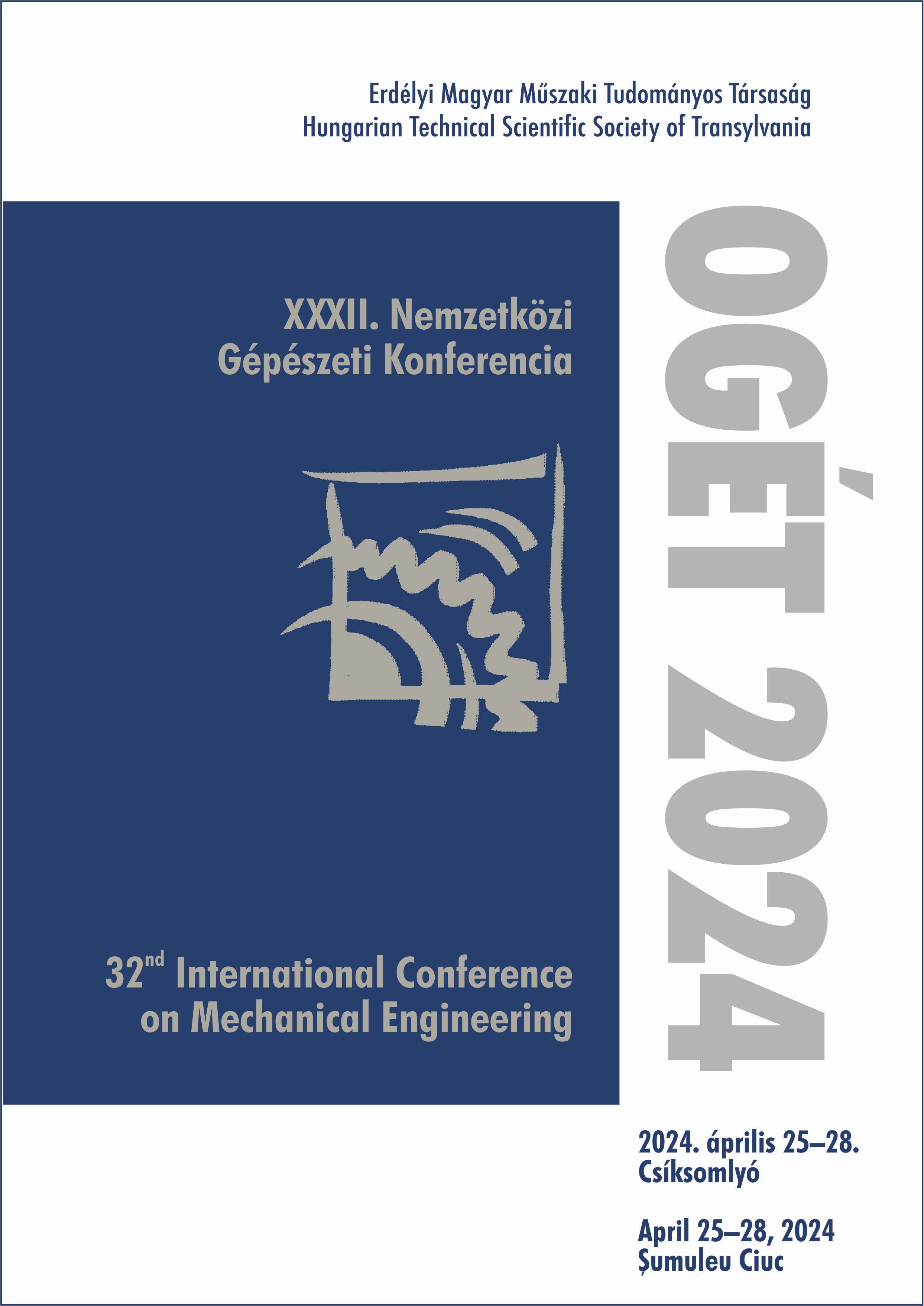Rekonstrukciós megoldások CT felvétel alapján készített állkapocsra
Reconstruction solutions for a jaw based on a CT scan
Keywords:
Reverse Engineering, Finite element analysis, Computed Tomography (CT), Implant, Surface modelling, /, Végeselem analízis, Implantátum, FelületmodellezésAbstract
This paper presents a back modeling of the relationship between a lower tooth and the lower jaw and possible finite element analysis methods. The primary goal of the study is to test the tooth-bone relationship itself on a more accurate geometric model. In most of the studies reviewed, a very simplified model is investigated, where each layer of tooth and jaw bone is not treated separately. In our study, the back-modelling focused on reproducing the integration of the tooth into the jaw, which allowed us to decompose the model into layers and to perform a computer simulation study of the whole model. The solid parts of the layered 3D model thus provided the opportunity to apply different material properties to different regions in the finite element analysis.
Kivonat
Jelen tanulmány egy alsó fog és az alsó állkapocs közötti kapcsolat visszamodellezését és lehetséges végeselem analízis módszereit tartalmazza. A tanulmány elsődleges célja, hogy egy sokkal pontosabb geometriai modellen teszteljük le magát a fog és a csont kapcsolatát. A legtöbb megvizsgált tanulmányban egy nagyon leegyszerűsített modellt vizsgálnak, ahol a fog és az állkapocs csont egyes rétegei nincsenek külön kezelve. A mi kutatásunkban a visszamodellezés a fogak állkapocsba való integrációjának reprodukálására összpontosított, amivel lehetőség nyílt a modellek rétegekre bontására és a teljes modell számítógépes szimulációs vizsgálatára. A rétegekre osztott 3D modell szilárd részei ezáltal lehetőséget biztosítottak arra, hogy a végeselemes analízis során különböző anyagtulajdonságokat alkalmazzunk a különböző régiókban.
References
Katarzyna Dobroś, Justyna Hajto-Bryk, Joanna Zarzecka: The 3D printed teeth models intended for hands-on practice in conservative dentistry, 2022, DOI: 10.24425/fmc.2022.141689
Dong-Xu L, Hong-Ning W, Chun-Ling W, Hong L, Ping S, Xiao Y.: Modulus of elasticity of human periodontal ligament by optical measurement and numerical simulation. Angle Orthod. 2011, DOI: 10.2319/060710-311.1
Fill TS, Carey JP, Toogood RW, Major PW.: Experimentally determined mechanical properties of, and models for, the periodontal ligament: critical review of current literature. J Dent Biomech. 2011, DOI: 10.4061/2011/312980
Giannini M, Soares CJ, de Carvalho RM.: Ultimate tensile strength of tooth structures. Dent Mater. 2004, DOI: 10.1016/S0109-5641(03)00110-6
Gradl R, Zanette I, Ruiz-Yaniz M, Dierolf M, Rack A, Zaslansky P, Pfeiffer F. Mass: Density Measurement of Mineralized Tissue with Grating-Based X-Ray Phase Tomography, 2016, DOI: 10.1371/journal.pone.0167797
Habelitz S, Marshall SJ, Marshall GW Jr, Balooch M.: Mechanical properties of human dental enamel on the nanometre scale. Arch Oral Biol. 2001, DOI: 10.1016/s0003-9969(00)00089-3
Hai Yen Mai, Hang-Nga Mai, Du-Hyeong Lee: Computer-Based 3D Simulation Method in Dental Occlusion Education: Student Response and Learning Effect, 2020, DOI: 10.3390/app10176073
Christoph J. Roser, Andreas Zenthöfer, Christopher J. Lux, Stefan Rues: A new CAD/CAM tooth mobility simulating model for dental in vitro investigations, 2023, DOI: 27, pages 5131–5140
Moga RA, Buru SM, Chiorean CG, Cosgarea R.: Compressive stress in periodontal ligament under orthodontic movements during periodontal breakdown. Am J Orthod Dentofacial Orthop. 2021, DOI: 10.1016/j.ajodo.2020.10.021
Ralph WJ.: Tensile behaviour of the periodontal ligament. J Periodontal Res. 1982, DOI: 10.1111/j.1600-0765.1982.tb01172.x.
Martin Richter, Thorsten Peter, Stefan Rüttermann, Robert Sader, Lukas B. Seifert: 3D printed versus commercial models in undergraduate conservative dentistry training, 2021, DOI: 10.1111/eje.12742
Rees JS, Jacobsen PH. Elastic modulus of the periodontal ligament. Biomaterials. 1997, DOI: 10.1016/s0142-9612(97)00021-5
Ritthiti A, Sattabanasuk V, Karunratanakul K, Senawongse P.: Effect of Stress Generated by Occlusal Cyclic Force on Class I Bulk-Fill Composite Restoration Microleakage. Eur J Dent. 2022, DOI: 10.1055/s-0041-1735433
Toparli M, Koksal NS.: Hardness and yield strength of dentin from simulated nano-indentation tests. Comput Methods Programs Biomed. 2005, DOI: 10.1016/j.cmpb.2004.11.003
Weir CE.: Effect of Temperature on the Volume of Leather and Collagen in Water. Journal of Research of the National Bureau of Standards, 1948
Xu HC, Liu WY, Wang T.: Measurement of thermal expansion coefficient of human teeth. Aust Dent J. 1989, DOI: 10.1111/j.1834-7819.1989.tb04660.x.
Tianran Yuan, Ning Dai, Wenhe Liao, Xiaosheng Cheng: Single-Tooth Modeling for 3D Dental Model, 2010, DOI: 10.1155/2010/535329
Zhang YR, Du W, Zhou XD, Yu HY.: Review of research on the mechanical properties of the human tooth. Int J Oral Sci, 2014, DOI: 10.1038/ijos.2014.21
Ziskind D, Hasday M, Cohen SR, Wagner HD.: Young's modulus of peritubular and intertubular human dentin by nano-indentation tests. J Struct Biol. 2011, DOI: 10.1016/j.jsb.2010.09.010
Ganesh Pandurang Mengal, Jyoti Nadgere, Sabita M Ram, Naisargi Shah: A Comparative Evaluation of Stress Distribution by Three Different Designs of Prefabricated Metal Posts on Endodontically Treated Permanent Maxillary Central Incisor: A Three-dimensional Finite Element Study, Journal of Contemporary Dentistr, 2015
Johnny G. Cailleteau, MS, DDS, MS, Monty R. Rieger, MS, PhD, and J. Ed Akin, PhD: A Comparison of Intracanal Stresses in a Post- Restored Tooth Utilizing the Finite Element Method, JOURNAL OF ENDODONTIC, 1992
Morin DL, Douglas WH, Cross M, DeLong R.: Biophysical stress analysis of restored teeth: experimental strain measurement, Dent Mater, 1988
Ronald Ordinola-Zapata, Fei Lin, Sanket Nagarkar, Jorge Perdigão: A critical analysis of research methods and experimental models to study the load capacity and clinical behaviour of the root filled teeth, International Endodontic Journal, 2022
AM Shaw, GT Sameshima, HV Vu: Mechanical stress generated by orthodontic forces on apical root cementum: a finite element model, Orthod Craniofacial Res 7, 2004
Shoeb Yakub Shaikh, Shahnawaz Mulani, Safia Shoeb Shaikh: Stress Distribution on Root Dentin Analogous to Natural Teeth with Various Retentive Channels Design on the Face of the Root with Minimal or No Coronal Tooth Structure: A Finite Element Analysis, Contemporary Clinical Dentistry, 2019
Franco, A.B.G., Franco, A.G., de Carvalho, G.A.P., Ramos, E.V., Amorim, J.C.F. & de Martim, A.S. (2020) Influence of conservative endodontic access and the osteoporotic bone on the restoration material adhesive behavior through finite element analysis. Journal of Materials Science: Materials in Medicine, 31, 2–7
Liu, S., Liu, Y., Xu, J., Rong, Q. & Pan, S. (2014) Influence of occlusal contact and cusp inclination on the biomechanical character of a maxillary premolar: a finite element analysis. Journal of Prosthetic Dentistry, 112, 1238–1245


